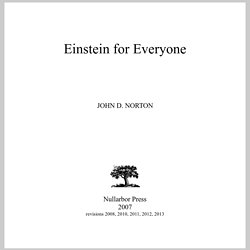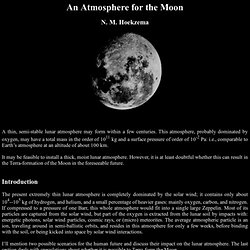

Einstein for Everyone. Einstein for Everyone Nullarbor Press 2007revisions 2008, 2010, 2011, 2012, 2013 Copyright 2007, 2008, 2010, 2011, 2012, 2013 John D.

Norton Published by Nullarbor Press, 500 Fifth Avenue, Pittsburgh, Pennsylvania 15260 with offices in Liberty Ave., Pittsburgh, Pennsylvania, 15222 All Rights Reserved John D. An advanced sequel is planned in this series:Einstein for Almost Everyone 2 4 6 8 9 7 5 3 1 ePrinted in the United States of America no trees were harmed web*bookTM This book is a continuing work in progress. January 1, 2015. Preface For over a decade I have taught an introductory, undergraduate class, "Einstein for Everyone," at the University of Pittsburgh to anyone interested enough to walk through door.
With each new offering of the course, I had the chance to find out what content worked and which of my ever so clever pedagogical inventions were failures. At the same time, my lecture notes have evolved. This text owes a lot to many. TOP TEN UNSOLVED PROBLEMS IN PHYSICS. An Atmosphere for the Moon. An Atmosphere for the Moon N.

M. Hoekzema A thin, semi-stable lunar atmosphere may form within a few centuries. This atmosphere, probably dominated by oxygen, may have a total mass in the order of 1011 kg and a surface pressure of order of 10-2 Pa: i.e., comparable to Earth’s atmosphere at an altitude of about 100 km. Multiple Star Orbits. Binary and multiple star systems are very common in our universe.

About half of all stars are found in systems containing two or more stars. This web page shows the typical orbits for stars in binary, triple and quadruple star systems. These simulations show perfect star systems with stars of equal masses. Real multiple star systems are usually messier with stars of different masses at very different distances. Binary Star Systems Shown on the left is a typical binary star system. Triple Star Systems Shown on the left is a typical triple star system. Quadruple Star Systems. Simple Electric Generator. All metals contain a movable substance called "electric charge".

Even uncharged wires are full of charge! After all, the atoms of the metal are made half of positive protons and half of negative electrons. Metals are special because their electrons don't stay connected to the metal atoms, instead they fly around inside the metal and form a type of electric "liquid" inside the wires. Apply to DEVELOP. International Applicants International applicants interested in working with the DEVELOP Program must be currently registered at an accredited U.S. school.

International applicants are not eligible to apply to NASA Center Locations, however, they are eligible to apply to Regional Locations and Leveraged Academic Locations. There is an exception for the NSSTC (Marshall Space Flight Center) that allows international applicants to apply to that location. Acceptances for international applicants are conditional upon proof of a visa or approved OPT that will allow them to legally work within the U.S. applicants who do not meet these requirements are not eligible to participate in the DEVELOP Program.
Locations International Students can apply to: DEVELOP's Nepal Location DEVELOP has one international node located at the International Centre for Integrated Mountain Development (ICIMOD) in Kathmandu, Nepal. Do you have questions regarding an internship with DEVELOP? How to build a Tesla Coil. Chemistry and Physics Courses. Freshmen Physics I Class - Classical Mechanics. Graduate Level Quantum Mechanics Course. Supernova Condensate. Esterification. Step 1 In the first step, the ethanoic acid takes a proton (a hydrogen ion) from the concentrated sulphuric acid.

The proton becomes attached to one of the lone pairs on the oxygen which is double-bonded to the carbon. The transfer of the proton to the oxygen gives it a positive charge, but it is actually misleading to draw the structure in this way (although nearly everybody does!). The positive charge is delocalised over the whole of the right-hand end of the ion, with a fair amount of positiveness on the carbon atom. In other words, you can think of an electron pair shifting to give this structure: You could also imagine another electron pair shift producing a third structure: Chemistry Web Reference Book.